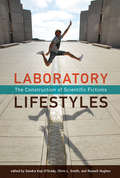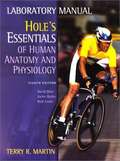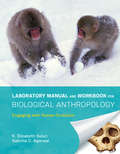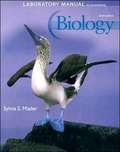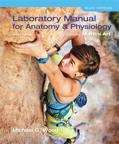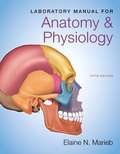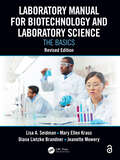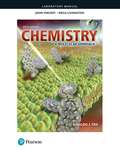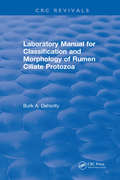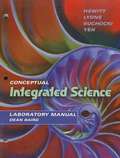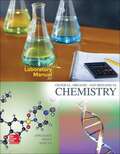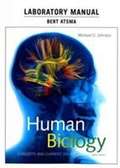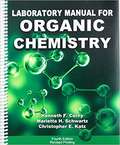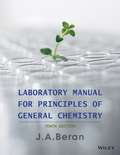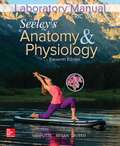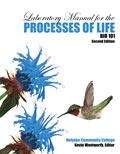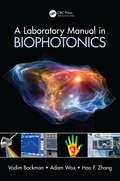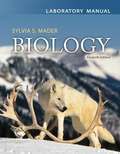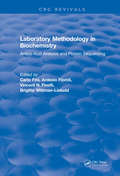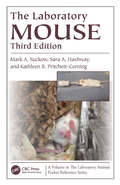- Table View
- List View
Laboratory Lifestyles: The Construction of Scientific Fictions (Leonardo)
by Sandra Kaji-O'Grady Chris Smith Russell HughesA generously illustrated examination of the boom in luxurious, resort-style scientific laboratories and how this affects scientists' work. The past decade has seen an extraordinary laboratory-building boom. This new crop of laboratories features spectacular architecture and resort-like amenities. The buildings sprawl luxuriously on verdant campuses or sit sleekly in expensive urban neighborhoods. Designed to attract venture capital, generous philanthropy, and star scientists, these laboratories are meant to create the ideal conditions for scientific discovery. Yet there is little empirical evidence that shows if they do. Laboratory Lifestyles examines this new species of scientific laboratory from architectural, economic, social, and scientific perspectives. Generously illustrated with photographs of laboratories and scientists at work in them, the book investigates how “lifestyle science” affects actual science. Are scientists working when they stretch in a yoga class, play volleyball in the company tournament, chat in an on-site café, or show off their facilities to visiting pharmaceutical executives?The book describes, among other things, the role of beanbag chairs in the construction of science at Xerox PARC; the Southern California vibe of the RAND Corporation (Malibu), General Atomic (La Jolla), and Hughes Research Laboratories (Malibu); and Biosphere 2's “bionauts” as both scientists and scientific subjects; and interstellar laboratories. Laboratory Lifestyles (the title is an allusion to Bruno Latour and Steve Woolgar's influential Laboratory Life) documents a shift in what constitutes scientific practice; these laboratories and their lifestyles are as experimental as the science they cultivate. Contributors Kathleen Brandt, Russell Hughes, Tim Ivison, Sandra Kaji-O'Grady, Stuart W. Leslie, Brian Lonsway, Sean O'Halloran, Simon Sadler, Chris L. Smith, Nicole Sully, Ksenia Tatarchenko, William Taylor, Julia Tcharfas, Albena Yaneva, Stelios Zavos
Laboratory Manual: Hole's Essentials of Human Anatomy and Physiology
by Terry R. MartinThis laboratory manual is designed for students with minimal backgrounds in the physical and biological sciences who are pursuing careers in allied health fields.
Laboratory Manual and Workbook for Biological Anthropology
by K. Elizabeth Soluri Sabrina C. AgarwalThe perfect lab solution. A vividly illustrated, flexible, and topically balanced manual with a critical-thinking approach
Laboratory Manual Biology
by Sylvia S. MaderThe Biology Laboratory Manual, Tenth Edition, is written by Dr. Sylvia Mader. With few exceptions, each chapter in the text has an accompanying laboratory exercise in the manual. Every laboratory has been written to help students learn the fundamental concepts of biology and the specific content of the chapter to which the lab relates, and to gain a better understanding of the scientific method.
Laboratory Manual For Anatomy And Physiology Featuring Martini Art, Main Version
by Michael WoodThis laboratory manual is designed to serve the lab course that accompanies the two-semester anatomy and physiology lecture course. It provides students with comprehensive coverage of anatomy and physiology, beautiful full-color art and photographs, and an intuitive pedagogical framework. The primary goals of this manual are to provide students with hands-on experiences that reinforce the information they learn in the lecture course and to help them understand three-dimensional relationships, visualize complex structures, and comprehend intricate physiological processes. The manual is written to correspond to all current two-semester anatomy and physiology textbooks, although those students and instructors using Fundamentals of Anatomy & Physiology, Tenth Edition, by Frederic H. Martini, Judi L. Nath, and Edwin F. Bartholomew will recognize here some of the superb art from that text by William Ober and Claire Garrison, Martini's renowned biomedical illustrators. This sixth edition manual is available in three separate versions. The Main Version covers the full two-semester A&P curriculum, including dissections of the cow eye and of the sheep heart, brain, and kidney. The Cat Version includes all of the same material plus an additional section of nine cat dissection exercises encompassing the major body systems. The Pig Version, similarly, includes all of the material from the Main Version with a separate section of nine fetal pig dissection exercises. The Cat and Pig Versions make the manual more useful to instructors whose students perform animal dissections in the lab. The outstanding dissections and accompanying photographs are by Shawn Miller and Mark Neilsen and I thank each of them for their expertise.
Laboratory Manual for Anatomy & Physiology (Fifth Edition)
by Elaine N. MariebThis laboratory manual is designed for instructors who teach a two-semester introductory anatomy & physiology course, but do not require the full range of laboratory exercises found in Marieb’s best-selling Human Anatomy & Physiology Lab Manuals (Cat, Fetal Pig, and Main).
Laboratory Manual for Biotechnology and Laboratory Science: The Basics, Revised Edition
by Lisa A. Seidman Mary Ellen Kraus Diana Lietzke Brandner Jeanette MoweryProvides the basic laboratory skills and knowledge to pursue a career in biotechnology. Written by four biotechnology instructors with over 20 years of teaching experience, it incorporates instruction, exercises, and laboratory activities that the authors have been using and perfecting for years. These exercises and activities help students understand the fundamentals of working in a biotechnology laboratory. Building skills through an organized and systematic presentation of materials, procedures, and tasks, the manual explores overarching themes that relate to all biotechnology workplaces including forensic, clinical, quality control, environmental, and other testing laboratories.Features:• Provides clear instructions and step-by-step exercises to make learning the material easier for students. There are Lab Notes for Instructors in the Support Material (see tab below).• Emphasizes fundamental laboratory skills that prepare students for the industry.• Builds students’ skills through an organized and systematic presentation of materials, procedures, and tasks.• Updates reflect recent innovations and regulatory requirements to ensure students stay up to date.• Supplies skills suitable for careers in forensic, clinical, quality control, environmental, and other testing laboratories.
Laboratory Manual for Chemistry: A Molecular Approach
by Nivaldo Tro John Vincent Erica LivingstonUpdated for the new edition of Chemistry: A Molecular Approach, this manual contains twenty-nine experiments with a focus on real world applications. Each experiment contains a set of pre-laboratory questions, an introduction, a step-by-step procedure (including safety information and a report section featuring post-laboratory questions). Additional features include a section on laboratory safety rules, an overview on general techniques and equipment, as well as a detailed tutorial on graphing data in Excel.
Laboratory Manual for Classification and Morphology of Rumen Ciliate Protozoa
by B.A. DehorityThe only rumen protozoa lab guide featuring line drawings created by a leading scientist in the fieldLaboratory Manual for Classification and Morphology of Rumen Ciliate Protozoa is a unique lab guide for learning how to count and identify rumen protozoa. In this guide, Professor Dehority has created line drawings of rumen protozoa that emphasize morphological features and size measurements. The book also provides keys for identifying genera and species, and it contains classifications and descriptions of the different orders and families of rumen ciliate protozoa. Procedures for counting rumen protozoa and identifying individual species are included as well.Laboratory Manual for Classification and Morphology of Rumen Ciliate Protozoa will be an excellent identification guide for protozoologists, microbiologists, dairy scientists, and any researcher or student working with rumen protozoa.
Laboratory Manual For Conceptual Integrated Science
by Paul G. Hewitt Suzanne A. Lyons John A. Suchocki Jennifer YehThis guide provides a variety of hands-on activities and experiments that complement the Active Explorations throughout the text.
Laboratory Manual for General, Organic, and Biological Chemistry
by Cindy Applegate Mary Bethe Neely Michael SakutaThe Laboratory Manual for General, Organic, and Biological Chemistry by Applegate, Neely, and Sakuta was authored to be the most current lab manual available for the GOB market, incorporating the most modern instrumentation and techniques. Illustrations and chemical structures were developed by the authors to conform to the most recent IUPAC conventions. A problem solving methodology is also utilized throughout the laboratory exercises. The Laboratory Manual for General, Organic, and Biological Chemistry by Applegate, Neely, and Sakuta is also designed with flexibility in mind to meet the differing lengths of GOB courses and variety of instrumentation available in GOB labs. Helpful instructor materials are also available on this companion website, including answers, solution recipes, best practices with common student issues and TA advice, sample syllabi, and a calculation sheet for the Density lab.
Laboratory Manual For Human Biology: Concepts And Current Issues
by Michael D. Johnson Bert AtsmaThe Laboratory Manual provides an emphasis on critical thinking and includes Safety Guidelines, Objectives, A List of Materials Needed, Topic Introduction, Activities with embedded questions, and Critical Thinking Questions.
Laboratory Manual for Organic Chemistry
by Kenneth F Cerny Marietta H Schwartz Christopher E KatzThis new manual takes students of organic chemistry through a multitude of basic laboratory techniques such as reaction setup, reflux, distillation, recrystallization, thin layer chromatography and many others. Modern spectroscopic techniques such as UV-Vis, FT-IR, and NMR are reviewed and utilized as a part of many experiments. As with all editions of this manual, the authors include pre-laboratory hand-in assignments and post experiment study questions.
Laboratory Manual for Principles of General Chemistry (Tenth Edition)
by Jo Allan BeranPre-laboratory Assignment Questions emphasize the chemical principles presented in the introduction of the experiment. Representative calculations, data analysis, and points of emphasis required for the completion of the Experimental Procedure are also addressed in the Pre-laboratory Assignment. ?h Laboratory Questions help promote a deeper understanding of the experiment and help students recognize where chemical principles can be used for interpreting unexpected data or ?turning points? in the experiment. In-depth discussion of lab techniques and easy-to-reference techniques icons: Lab techniques are covered in the front of the manual and are assigned an icon. The icons are placed in the margin of the text at the appropriate point at which to use the technique. ?h Safety and Disposal Icons: Icons contained in the Experimental Procedures indicate safety cautions and provide information regarding the correct disposal of test solutions. Strong coverage/emphasis on safety. Illustrations and clear procedures make it a good reference for students. Offers Dry Labs that can be done outside the lab setting. Offers easy custom pub options. Extensive background information offered within each lab. Can be used with any text.
Laboratory Manual for Saladin's Anatomy & Physiology
by Eric WiseWritten by Eric Wise of Santa Barbara City College, this comprehensive manual contains 41 laboratory exercises that are integrated closely with the Saladin Anatomy and Physiology textbook. Each exercise demonstrates key anatomical and physiological facts and principles presented in Anatomy and Physiology by directing students to investigate specific concepts in greater detail.
Laboratory Manual for Seeley's Anatomy and Physiology (11th Edition)
by Eric WiseLaboratory Manual For Seeley's Anatomy And Physiology, Eleventh Edition
Laboratory Manual for the Processes of Life: Bio 101, Second Edition
by Kevin WentworthHolyoke Community College Lab Manual for Bio 101
A Laboratory Manual in Biophotonics
by Vadim Backman Adam Wax Hao F. ZhangBiophotonics is a burgeoning field that has afforded researchers and medical practitioners alike an invaluable tool for implementing optical microscopy. Recent advances in research have enabled scientists to measure and visualize the structural composition of cells and tissue while generating applications that aid in the detection of diseases such as cancer, Alzheimer’s, and atherosclerosis. Rather than divulge a perfunctory glance into the field of biophotonics, this textbook aims to fully immerse senior undergraduates, graduates, and research professionals in the fundamental knowledge necessary for acquiring a more advanced awareness of concepts and pushing the field beyond its current boundaries. The authors furnish readers with a pragmatic, quantitative, and systematic view of biophotonics, engaging such topics as light-tissue interaction, the use of optical instrumentation, and formulating new methods for performing analysis. Designed for use in classroom lectures, seminars, or professional laboratories, the inclusion and incorporation of this textbook can greatly benefit readers as it serves as a comprehensive introduction to current optical techniques used in biomedical applications. Caters to the needs of graduate and undergraduate students as well as R&D professionals engaged in biophotonics research. Guides readers in the field of biophotonics, beginning with basic concepts before proceeding to more advanced topics and applications. Serves as a primary text for attaining an in-depth, systematic view of principles and applications related to biophotonics. Presents a quantitative overview of the fundamentals of biophotonic technologies. Equips readers to apply fundamentals to practical aspects of biophotonics.
Laboratory Manual to accompany Biology, Eleventh Edition
by Sylvia S. MaderThis manual helps students learn the fundamental concepts of biology and the specific content of the chapter to which the lab relates, and to gain a better understanding of the scientific method.
Laboratory Manual to Accompany Introductory D.C/ A.C. Electronics (Fourth Edition) and Introductory DC/AC Circuits (Fourth Edition)
by Nigel P. Cook Gary Lancaster Hugh ScrivenLaboratory Manual to Accompany INTRODUCTORY DC/AC ELECTRONICS and INTRODUCTORY DC/AC CIRCUITS
Laboratory Manual to Accompany Introductory D.C/ A.C. Electronics (Fourth Edition) and Introductory DC/AC Circuits (Fourth Edition)
by Nigel P. Cook Gary Lancaster Hugh ScrivenLaboratory Manual to Accompany INTRODUCTORY DC/AC ELECTRONICS and INTRODUCTORY DC/AC CIRCUITS
Laboratory Methodology in Biochemistry: Amino Acid Analysis and Protein Sequencing
by Carlo FiniProvides information on methodologies and techniques concerning the biochemical laboratory, as well as improvements or advancements made on existing methodologies. Original methodologies for the purification of biological macromolecules and methodologies for metabolic pathways and enzyme kinetics are covered. The application of biochemical and biophysical methodologies for the structural and dynamic characterization of biological macromolecules is considered. The elaboration of automated systems for biochemical research and computer programs for the management and processing of experimental data are both reviewed. Development of instruments and equipment for biochemical research is also presented.
Laboratory Micro-X-Ray Fluorescence Spectroscopy
by Michael HaschkeMicro-X-ray fluorescence offers the possibility for a position- sensitive and non-destructive analysis that can be used for the analysis of non-homogeneous materials and layer systems. This analytical technique has shown a dynamic development in the last 15 years and is used for the analysis of small particles, inclusions, of elemental distributions for a wide range of different applications both in research and quality control. The first experiments were performed on synchrotrons but there is a requirement for laboratory instruments which offers a fast and immediate access for analytical results. The book discuss the main components of a µ-XRF instrument and the different measurement modes, it gives an overview about the various instruments types, considers the special requirements for quantification of non-homogeneous materials and presents a wide range of application for single point and multi-point analysis as well as for distribution analysis in one, two and three dimensions.
The Laboratory Mouse: A Guide to the Location and Orientation of Tissues for Optimal Histological Evaluation
by Jennifer Johnson Brian DelGiudice Dinesh Bangari Eleanor Peterson Gregory Ulinski Susan Ryan Beth ThurbergKey features: High quality full color photographs and descriptive texts on the location and removal of the organs from the mouse Instructive methods and clear visuals for trimming and orienting the organs for paraffin histology to obtain the best possible sections for analysis Full color photomicrographs of the resulting section for each organ stained with hematoxylin and eosin demonstrating important features and landmarks for the histologist to ensure the optimal area for analysis is achieved All in one, easy to use guide organized by individual organs of the laboratory mouse Spiralbound for easy reference in the lab This "one-stop" guide offers an essential resource for any academic, research or development operation where mouse necropsy and/or histology are performed. Connecting the reader ‘from the mouse to the microscope’, it provides a detailed guide for locating, trimming, orientating and embedding of the most frequently investigated tissues collected in the laboratory mouse. It shows where the organs reside in the mouse, how to trim and embed them as well as the resulting optimal sections. This guide brings together the wealth of scattered information into one high-quality text, the emphasis is on providing knowledge that will help histologists and scientists get better results in any downstream assays where ideal sections are needed.
The Laboratory Mouse (Laboratory Animal Pocket Reference)
by Mark A. Suckow Sara Hashway Kathleen R. Pritchett-CorningWith the advent of transgenic and other genetic engineering technologies, the versatility and usefulness of the mouse as a model in biomedical research has soared. Revised to reflect advances since the second edition, The Laboratory Mouse continues to be the most accessible reference on the biology and care of the mouse in research settings. This guide presents basic information and common procedures in detail to provide a quick reference source for investigators, technicians, and caretakers on the humane care and use of the mouse. The new edition adds information on novel technologies such as CRISPR-Cas and on housing systems and management practices; it covers new concepts such as pain assessment by facial expression and the importance of nest-building as an assessment tool of well-being. There are now expanded sections on anesthesia and analgesia, and on behavior and enrichment. An ideal quick reference for investigators, technicians, and animal caretakers charged with the care and/or use of mice in a research setting, this book will be particularly valuable to those new to working with mice who need to start research programs using these animals.
